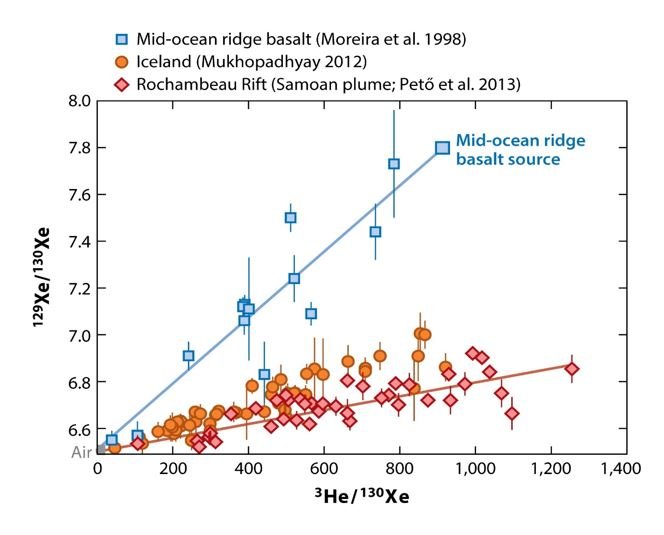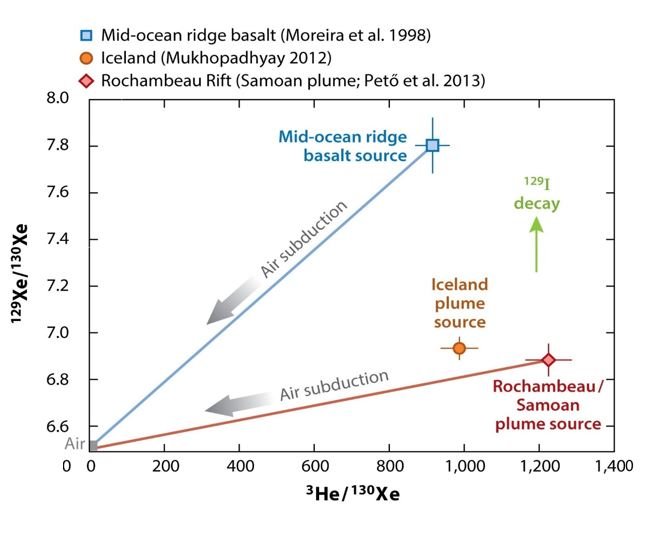Sujoy Mukhopadhyay on Probing the Hadean World with Noble Gases
Listen to the podcast here, or wherever you get your podcasts.
Sujoy Mukhopadhyay’s research group has developed new techniques for measuring the trace abundances of noble gases in Earth materials. Noble gases are powerful probes into the very early Earth because their inert nature makes them immune to chemical processes that tend to erase signatures of the early Earth. In the podcast, Sujoy Mukhopadhyay describes how he measures noble gases within two kinds of basalt — ocean island basalt and mid-ocean ridge basalt. It turns out that the two basalts have quite different amounts of an isotope of xenon. He then argues that this points to a source reservoir in the deep mantle that retains a distinct identity forged in the first 100 million years of Earth history.
In the picture, Sujoy Mukhopadhyay is standing next to the mass spectrometer used to measure the abundances and isotopic ratios of nobles gases. The chamber used for crushing basalt is highlighted by the red box.
Sujoy Mukhopadhyay is Professor of Geochemistry at the University of California, Davis.
Podcast Illustrations
Illustrations courtesy of Sujoy Mukhopadhyay unless otherwise noted.
Artist impression of the early Earth showing solidification of a magma ocean and outgassing of the mantle. When the Earth formed, noble gases were trapped in the mantle. During subsequent partial or complete melting, noble gases preferentially enter the liquid phase. If the liquid approaches the surface, they preferentially enter bubbles of gases (mainly composed of carbon dioxide and water) that form as the pressure drops. When the melt reaches the surface, the bubbles can escape into the atmosphere.
Courtesy of Don Dixon
Lavas erupting on ocean islands are thought to originate from the deepest parts of the mantle. The eruption shown here occurred in 2021 on La Palma in the Canary Islands.
Copernicus Sentinel-2 satellite, ESA
Lavas erupting from mid-ocean ridges, where new seafloor is created, are thought to originate from relatively shallow parts of the mantle. The pillow lava shown above erupted from the Juan de Fuca Ridge about 150 miles off the coast of Oregon.
NOAA
When magma erupts under water, it cools rapidly, forming a glass of basaltic composition. The glass contains tiny bubbles of volatile materials that emerge as the rising mantle source decompresses and melts.
Experimental Results
Plots of noble gas isotope measurements using the technique of progressively crushing a basalt, as described in the podcast. The blue points represent results from a mid-ocean basalt, and the orange and red points represent results from ocean-island-type basalts. The two types of basalt plot along separate lines, which can only be explained if the ocean-island-type basalt source reservoir contains less 129Xe than the mid-ocean ridge basalt source. Since 129Xe production is essentially complete by 100 million years after Earth formation (i.e., after about 6 half-lives of the 129 iodine decay process), the ocean island reservoir must have differentiated from the mid-ocean ridge reservoir during the first 100 million years of Earth history, i.e., over 4.5 billion years ago.
Mukhopadhyay, S., & Parai R. (2019), Annual Review of Earth and Planetary Sciences 47, 389
Plot showing the expected correlation of the ratio of xenon isotopes with the helium 3 to xenon ratio for source materials with two different noble gas compositions. The 129Xe is only produced by radioactive decay of 129 iodine with a half-life of 16 million years. The other isotopes (130Xe and 3He) are primordial. The plot shows the effect of a varying amount of mixing of noble gases from the mantle sources with noble gases from the atmosphere. The more mixing (indicated by the air subduction arrows), the closer the noble gas ratios become to those of air. In the podcast, Sujoy Mukhopadhyay describes how progressive crushing of basalt samples leads to progressive release of gas from bubbles containing purer, i.e., less contaminated by air, mantle-derived noble gas.
If the two mantle sources had the same noble gas isotope ratios, the measurements would all fall on a single mixing line.
The green arrow indicates the effect of decay of 129 iodine during the first ~100 million years of Earth's history.
Mukhopadhyay, S., & Parai R. (2019), Annual Review of Earth and Planetary Sciences 47, 389
Large Low-Shear-Velocity Provinces as Possible Sources of Ocean Island Basalt
Map of the seismic-shear-wave velocity of the mantle at a depth of 2,800 km, just above the core-mantle boundary. The orange and red regions show large regions of low shear-wave velocity (LLSVP), which could be caused either by a higher temperature or an increased density as compared to the surroundings. The results discussed in the podcast suggest that denser material formed in the very early Earth has not homogenized with the rest of the mantle.
Torsvik, T.H. et al. (2010), Nature 466, 352
Cross section of the Earth’s mantle derived from high and low seismic shear wave velocity variations (blue and red, respectively). Since LLSVPs roughly coincide with the locations of plumes, it is hypothesized that they could be the source reservoirs of plumes. Some researchers have suggested that the LLSVPs are composed of subducted slab material (cooler, blue in the diagram). But the noble gas abundances demonstrate that the LLSVPs cannot be entirely composed of subducted slabs, and that they must have formed by 4.5 billion years ago, long before plate tectonics started. Numerical modeling of mantle flow shows how colder subducting oceanic slab material can pool separately from the LLSVPs near the core-mantle boundary. Allen McNamara discussed such models in his podcast.
Garnero E.J. & McNamara, A.K. (2008), Science 320, 626










